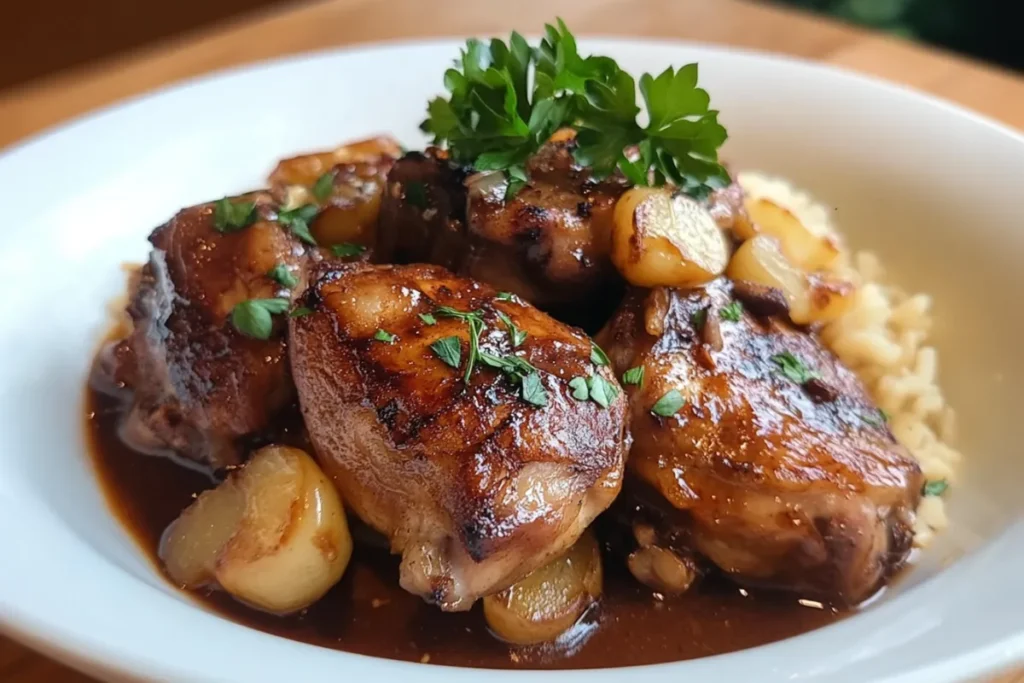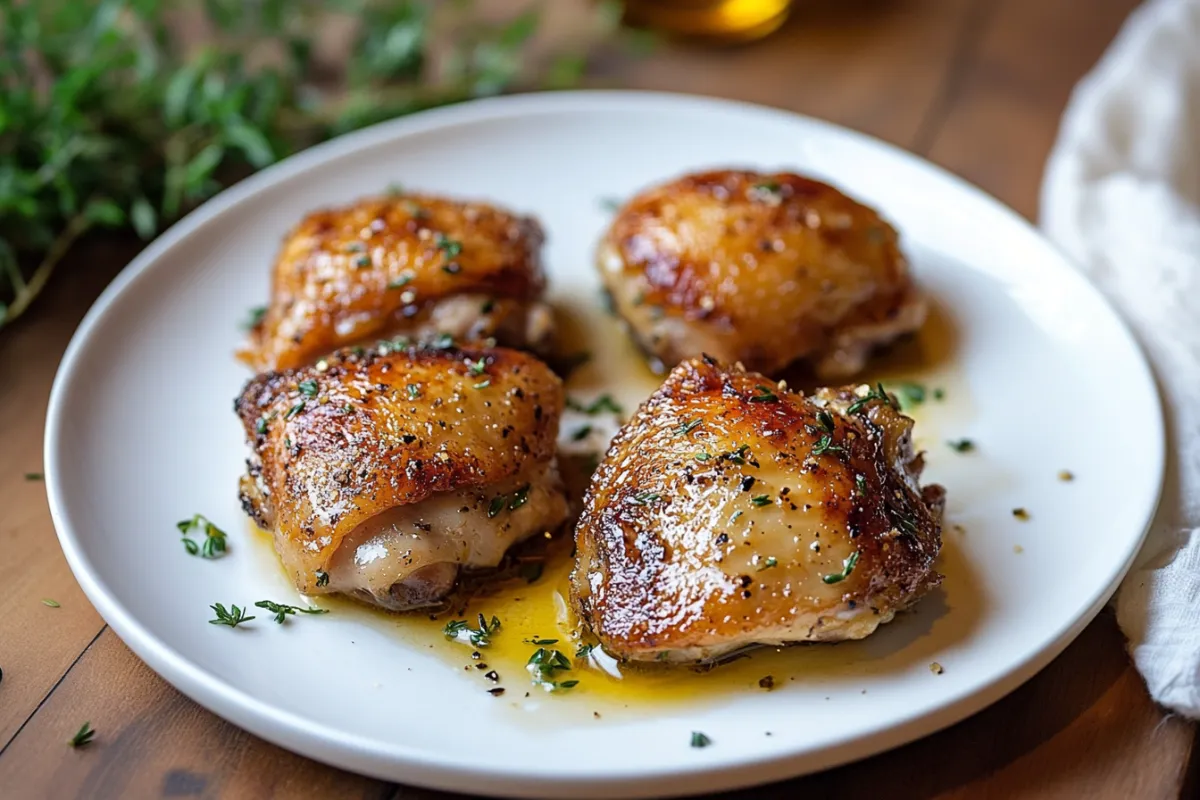Tender chicken thighs are a top choice for culinary experts due to their rich flavor and versatility. Dark meat, like chicken thighs, is often favored over white meat because of its higher fat content, which helps retain moisture and enhances tenderness. A common question among cooking enthusiasts is whether chicken thighs become more tender with prolonged cooking. This article will explore the biochemical processes behind tenderness, the best cooking techniques for achieving superior texture, and expert strategies to ensure the most flavorful results.
Understanding Chicken Thighs
What Are Chicken Thighs?

Chicken thighs are classified as dark meat, characterized by a higher fat content and a denser flavor compared to chicken breasts. The distinctive taste and succulence of chicken thighs are primarily attributed to their fat composition and connective tissue. The substantial presence of connective tissue necessitates specific cooking approaches to optimize tenderness. This makes chicken thighs an ideal candidate for recipes that require prolonged cooking to extract maximal flavor.
For an in-depth exploration of chicken anatomy and its culinary applications, refer to our comprehensive guide on different chicken cuts and their uses.
Chicken Thighs vs. Chicken Breasts
In contrast to chicken breasts, which are lean and highly susceptible to drying out, chicken thighs maintain their juiciness even under extended cooking durations. This quality is attributable to their higher fat and collagen content, which protects the meat from drying and enhances its succulence. Whereas chicken breasts require precise timing to prevent overcooking, chicken thighs are more forgiving, capable of withstanding longer cooking periods without compromising texture.
For additional insights into preventing chicken breasts from drying out, consider our expert guide on how to keep chicken breasts from drying out.
Anatomy and Composition of Chicken Thighs
The structure of chicken thighs includes significant quantities of fat and connective tissue. These tissues are rich in collagen, a protein that, when subjected to appropriate heat over a prolonged period, transforms into gelatin. This transformation is central to achieving the desired tenderness, as gelatin contributes to a moist and palatable texture. Understanding the biochemical processes at play allows cooks to manipulate cooking techniques for optimal results.
How Cooking Affects Tenderness
The Role of Connective Tissue and Collagen
The abundant collagen present in chicken thighs undergoes a thermal transformation into gelatin when exposed to low, sustained heat. Gelatin is important because it helps retain moisture, giving the meat a tender and succulent texture. This gelatinization process is critical to achieving tenderness, as gelatin enhances moisture retention, providing the characteristic succulent texture of well-cooked thighs. Moist cooking methods such as braising are particularly effective at promoting collagen breakdown.
For an advanced discussion on the science of collagen breakdown, refer to Collagen Breakdown in Meat Explained.
Slow Cooking vs. Fast Cooking Methods
Cooking methods that employ low temperatures over extended durations—such as braising, slow roasting, or utilizing a slow cooker—are optimal for converting collagen into gelatin. By contrast, high-temperature, rapid cooking methods can cause collagen to constrict, resulting in tougher meat. The gradual application of heat ensures that the collagen transitions smoothly into gelatin, thus enhancing tenderness.
For more sophisticated slow cooking strategies, explore our article on slow cooking tips for better tenderness.
Moisture Retention During Cooking
The preservation of moisture is paramount in achieving tender chicken thighs. Cooking techniques that incorporate a liquid element—such as braising or baking with a sealed cover—assist in maintaining moisture levels, thereby producing tender, juicy meat. Moisture also prevents the meat fibers from contracting excessively, which can occur during high-heat cooking. Covering the meat while cooking creates an environment rich in steam, further promoting tenderness.
Cooking Methods for Tender Chicken Thighs
Braising: The Superior Method for Tenderness
Braising is considered the gold standard for rendering chicken thighs tender. This technique involves searing the meat initially to develop flavor and subsequently simmering it in a liquid over a prolonged period. The combination of high initial heat and sustained, gentle cooking fosters the breakdown of connective tissues, while the liquid infuses the meat with robust flavors.
Slow Cooker Method
The use of a slow cooker facilitates the extended, low-temperature cooking necessary for collagen breakdown. Cooking chicken thighs at low temperatures for several hours results in exceptionally tender meat. Ensuring that an adequate amount of liquid is present in the cooker helps maintain moisture, thus preventing the thighs from drying out. Slow cooking also allows for the addition of various aromatic vegetables and spices, transforming the dish into a well-rounded culinary experience.
For additional benefits of slow cooking, visit Slow Cooking Benefits for Meat Tenderness.
Oven-Baked Chicken Thighs
Baking chicken thighs at moderate temperatures for extended periods can achieve tender results if moisture is adequately managed. Adding broth or marinade to the baking dish, along with covering the chicken with foil or a lid, assists in retaining moisture and amplifying flavor. The controlled heat environment provided by an oven is ideal for breaking down collagen without over-drying the meat.
Explore our detailed recipe for easy oven-baked chicken thighs for further guidance.
Grilling or Frying: Challenges and Considerations
While grilling and frying can develop a flavorful crust and crispy skin, achieving tenderness with these methods requires careful control of temperature and cooking duration. For example, searing the thighs over high heat for a few minutes to create a crust, then moving them to a cooler part of the grill to finish cooking slowly, can help maintain both tenderness and crispiness. The high, direct heat of grilling or frying can rapidly dry out the meat if not attentively managed. A hybrid approach—searing the meat quickly at high heat followed by finishing over indirect heat—can mitigate these issues, preserving the juicy interior while developing a pleasing exterior texture.
Does Cooking Time Always Make Chicken Thighs Tender?
The Role of Overcooking and Potential Toughness
Although prolonged cooking can often enhance tenderness, overcooking, particularly at high temperatures, can lead to a dry, fibrous texture. The challenge lies in striking a balance between sufficient cooking to break down collagen and overcooking, which depletes the meat of its inherent moisture. This is particularly important for dry-heat methods like baking and grilling, where moisture loss can occur rapidly.
Differences Between Bone-In and Boneless Chicken Thighs
Bone-in chicken thighs generally retain more moisture compared to boneless thighs due to the presence of bone, which helps to stabilize cooking temperatures and slow down moisture loss. The bone also imparts additional flavor through marrow and associated connective tissues. Bone-in thighs often require slightly longer cooking times, which can contribute to enhanced tenderness.
For a more detailed examination, refer to our guide on bone-in vs. boneless chicken cooking differences.
Cooking Time Guidelines Based on Method
- Braising: 45-60 minutes
- Baking: 35-45 minutes at 375°F (190°C)
- Slow Cooking: 4-6 hours on low
- Grilling/Frying: 10-15 minutes, with close monitoring to avoid overcooking
To achieve optimal tenderness, culinary precision is essential—using a timer and a meat thermometer will ensure that the chicken reaches the correct internal temperature without the risk of overcooking.
Factors That Influence Tenderness
Quality and Freshness of the Chicken
The tenderness of chicken thighs is significantly influenced by the quality and freshness of the meat. Fresh, high-quality chicken—preferably organic or free-range—contains higher levels of intramuscular fat, which promotes tenderness and flavor. Selecting chicken from reliable sources and ensuring freshness can greatly improve the final outcome.
Marinating and Pre-Cooking Preparations
The application of a marinade containing acidic ingredients (such as lemon juice or vinegar) aids in breaking down muscle fibers, thereby contributing to tenderness. Salt plays a complementary role, promoting osmosis, which helps retain moisture. A well-balanced marinade is an effective means of enhancing the texture of the meat, facilitating both moisture retention and flavor absorption.
For comprehensive marination strategies, refer to our article on how to marinate chicken for maximum tenderness.
Effective marinades often include enzymatic or acidic components, such as yogurt or buttermilk, which weaken muscle structure, leading to softer meat. Marination time and composition are critical factors that significantly impact tenderness.
The Role of Temperature
Temperature management is a pivotal element in the preparation of tender chicken thighs. Maintaining a consistent, low temperature (between 170-200°F or 75-95°C) for an extended duration ensures that collagen is adequately broken down, converting into gelatin without causing moisture loss. The temperature should be carefully monitored to achieve a balance between tenderizing the meat and avoiding dryness.
Common Mistakes That Affect Tenderness
Cooking at Too High a Temperature
Applying excessively high temperatures can cause the collagen in chicken thighs to constrict rapidly, leading to a tough and dry texture. High-heat methods can denature the proteins too quickly, preventing the gradual conversion of collagen to gelatin, which is essential for achieving a tender result.
Insufficient Cooking Time
Failing to provide adequate cooking time can leave the collagen intact, resulting in chewy and tough meat. The cooking process must allow for a gradual breakdown of collagen to gelatin, which is what gives the thighs their desired texture. Particularly with methods like braising or slow cooking, patience is key to ensuring that the meat reaches its full tender potential.
Skipping the Resting Period
Resting the meat after cooking is crucial to tenderness, as it allows for the redistribution of internal juices. Cutting into chicken thighs immediately after cooking can lead to significant moisture loss, resulting in a dry final product. Allowing the meat to rest ensures that the juices remain evenly distributed, contributing to a succulent texture.
Tips for Perfectly Tender Chicken Thighs
How to Know When Chicken Thighs Are Done
The internal temperature of chicken thighs should reach 175°F (80°C) to ensure tenderness. Unlike breast meat, thighs benefit from a higher endpoint temperature, which allows for thorough collagen breakdown without compromising moisture.
Using a Meat Thermometer for Accuracy
A meat thermometer is an invaluable tool for ensuring precision in cooking. By accurately gauging the internal temperature, one can prevent both undercooking and overcooking. This approach ensures consistency across batches, yielding perfectly tender thighs every time. For more on using a meat thermometer effectively, visit Tips for Using a Meat Thermometer.
Adding Moisture and Covering the Meat
Adding broth, water, or another form of moisture to the cooking environment, along with covering the dish, helps to trap steam and maintain optimal hydration. This technique is particularly advantageous for methods like baking or braising, where the goal is to ensure thorough collagen breakdown without allowing the meat to dry out.
Frequently Asked Questions (FAQs)
Do Chicken Thighs Get More Tender When Cooked Slowly?
Yes, cooking chicken thighs slowly allows for the gradual breakdown of collagen, resulting in tender, juicy meat. Low and slow methods such as braising or slow cooking are ideal for achieving maximum tenderness.
Can You Overcook Chicken Thighs?
While chicken thighs are more forgiving than breast meat, they can still be overcooked. Prolonged cooking at excessively high temperatures will result in dryness. The key is to maintain low to moderate heat to ensure tenderness without sacrificing moisture.
What Is the Ideal Internal Temperature for Tender Chicken Thighs?
The ideal internal temperature is 175°F (80°C). This temperature ensures that the collagen has adequately broken down, producing tender, juicy meat that retains its moisture and flavor.
Is It Better to Cook Chicken Thighs with or Without the Bone?
Bone-in chicken thighs generally yield more tender and flavorful results, as the bone helps retain moisture and imparts additional flavor. The bone also provides a buffer against overcooking, allowing for a more forgiving cooking process.
Conclusion
Achieving perfectly tender chicken thighs requires a nuanced understanding of both the biochemical properties of the meat and the appropriate cooking techniques. Whether utilizing braising, baking, or slow cooking, mastering the conversion of collagen to gelatin is key to obtaining a tender, flavorful product. By employing precise temperature control, sufficient cooking time, and proper resting practices, culinary professionals can consistently produce chicken thighs that are rich in flavor and texture, setting the standard for excellence in poultry preparation.

